Livelihood Vulnerability from Drought among Smallholder Livestock Farmers in South Africa
Abstract
1. Introduction
2. Materials and Methods
2.1. Study Area
2.2. Study Design
2.3. Sampling Procedure
2.4. Data Analysis
2.4.1. Livelihood Vulnerability Index
2.4.2. Livelihood Vulnerability Index-Intergovernmental Panel on Climate Change
3. Results
3.1. Social and Economic Characteristics of Livestock Farmers
3.2. Livelihood Vulnerability Index
3.3. Livelihood Vulnerability Index-Intergovernmental Panel on Climate Change
4. Discussion
5. Conclusions
Author Contributions
Funding
Institutional Review Board Statement
Informed Consent Statement
Data Availability Statement
Acknowledgments
Conflicts of Interest
References
- Abbass, K.; Zeeshan, M.; Huaming, Q.; Muntasir, S.; Mahmood, H. A review of the global climate change impacts, adaptation, and sustainable mitigation measures. Environ. Sci. Pollut. Res. 2022, 29, 42539–42559. [Google Scholar] [CrossRef]
- Lottering, S.; Mafongoya, P.; Lottering, R. Drought and its impacts on small-scale farmers in sub-Saharan Africa: A review. S. Afr. Geogr. J. 2021, 103, 319–341. [Google Scholar] [CrossRef]
- Nhemachena, C.; Nhamo, L.; Matchaya, G.; Nhemachena, C.R.; Muchara, B.; Karuaihe, S.T.; Mpandeli, S. Climate Change Impacts on Water and Agriculture Sectors in Southern Africa: Threats and opportunities for sustainable development. Water 2020, 12, 2673. [Google Scholar] [CrossRef]
- Bahta, Y.T.; Myeki, V.A. Adaptation, coping strategies and resilience of agricultural drought in South Africa: Implication for the sustainability of livestock sector. Heliyon 2021, 7, e08280. [Google Scholar] [CrossRef]
- Ogundeji, A.A. Adaptation to Climate Change and Impact on Smallholder Farmers’ Food Security in South Africa. Agriculture 2022, 12, 589. [Google Scholar] [CrossRef]
- Thao, N.T.T.; Khoi, D.N.; Xuan, T.T.; Tychon, B. Assessment of Livelihood Vulnerability to Drought: A Case Study in Dak Nong Province, Vietnam. Int. J. Disaster Risk Sci. 2019, 10, 604–615. [Google Scholar] [CrossRef]
- Mugandani, R.; Muziri, T.; Murewi, C.T.F.; Mugadza, A.; Chitata, T.; Sungirai, M.; Zirebwa, F.S.; Manhondo, P.; Mupfiga, E.T.; Nyamutowa, C.; et al. Mapping and Managing Livelihoods Vulnerability to Drought: A Case Study of Chivi District in Zimbabwe. Climate 2022, 10, 189. [Google Scholar] [CrossRef]
- Daniell, J.; Wenzel, F.; Schaefer, A. The economic costs of natural disasters globally from 1900–2015: Historical and normalised floods, storms, earthquakes, volcanoes, bushfires, drought and other disasters. In Geophysical Research Abstracts; Geophysical Insititute & Center for Disaster Management and Risk Reduction Technology, Karlsruhe Institute of Technology: Karlsruhe, Germany; Melbourne, VIC, Australia, 2016; p. 2016. [Google Scholar]
- Maltou, R.; Bahta, Y.T. Factors influencing the resilience of smallholder livestock farmers to agricultural drought in South Africa: Implication for adaptive capabilities. Disaster Risk Stud. 2019, 11, 4102. [Google Scholar] [CrossRef]
- Vetter, S. Effect of drought on communal livestock farmers in KwaZulu-Natal, South Africa. Afr. J. Range Forage Sci. 2020, 37, 93–106. [Google Scholar] [CrossRef]
- Bogale, G.A.; Erena, Z.B. Drought vulnerability and impacts of climate change on livestock production and productivity in different agro-Ecological zones of Ethiopia. J. Appl. Anim. Res. 2022, 50, 471–489. [Google Scholar] [CrossRef]
- Bahta, Y.T.; Myeki, V.A. The Impact of Agricultural Drought on Smallholder Livestock Farmers: Empirical Evidence Insights from Northern Cape, South Africa. Agriculture 2022, 12, 442. [Google Scholar] [CrossRef]
- Danso-abbeam, G.; Ogundeji, A.A.; Ojo, T.O.; Okolie, C.C. Livelihood Impact and Risk Management of Drought: The Experiences of Farming Households in the Free State Province, South Africa. Free. State. Nat. Hazards 2021. Preprint. [Google Scholar]
- Nordstrom, A.; Cotton, C. Impact of a Severe Drought on Education: More Schooling but Less Learning; Department of Economics, Queen’s University: Kingston, LO, Canada, 2020; pp. 1–31. [Google Scholar]
- Myeki, V.A.; Bahta, Y.T. Determinants of smallholder livestock farmers’ household resilience to food insecurity in South Africa. Climate 2021, 9, 117. [Google Scholar] [CrossRef]
- Kayastha, R.B.; Lee, W.K.; Shrestha, N.; Wang, S.W. Assessing the Livelihood Vulnerability of Nomads to Changing Climate in the Third Pole Region of Nepal. Land 2023, 12, 1105. [Google Scholar] [CrossRef]
- Maru, H.; Haileslassie, A.; Zeleke, T.; Esayas, B. Analysis of smallholders’ livelihood vulnerability to drought across agroecology and farm typology in the upper awash sub-basin, Ethiopia. Sustainability 2021, 13, 9764. [Google Scholar] [CrossRef]
- Tofu, D.A.; Haile, F.; Tolossa, T. Livelihood vulnerability and socio-economic determinants of households to climate change-induced recurrent drought in Ethiopia. GeoJournal 2023, 88, 5043–5067. [Google Scholar] [CrossRef]
- Bahta, Y.T.; Lombard, W.A. Nexus between Social Vulnerability and Resilience to Agricultural Drought amongst South African Smallholder Livestock Households. Atmosphere 2023, 14, 900. [Google Scholar] [CrossRef]
- RSA. Frances Baard District, Northern Cape: Profile and Analysis, District Development Model. 2020. Available online: https://municipalities.co.za/map/134/frances-baard-district-municipality (accessed on 25 April 2024).
- uMoya-NILU Consulting (Pty) Ltd. Air Quality Management Plan for the Northern Cape; Air Quality Baseline Assessment Report for Northern Cape Department of Environment and Nature Conservation, Report No. uMN072-2017; uMoya-NILU Consulting (Pty) Ltd.: Kimberley, South Africa, 2017. [Google Scholar]
- Melketo, T.; Schmidt, M.; Bonatti, M.; Sieber, S.; Müller, K.; Lana, M. Determinants of pastoral household resilience to food insecurity in Afar region, northeast Ethiopia. J. Arid. Environ. 2021, 188, 104454. [Google Scholar] [CrossRef]
- Stats, S.A. (Statistics South Africa), Community Survey 2016: Provincial Profile Northern Cape; Report No. 03-01-14; Statistics: Pretoria, South Africa, 2016. [Google Scholar]
- Northern Cape Department of Agriculture, Forestry, and Fisheries (NDAFF). Beneficiaries of an Agricultural Drought Relief Program; NDAFF: Kimberly, South Africa, 2020. [Google Scholar]
- Cochran, W.G. Sampling Techniques; John Wiley & Sons: Hoboken, NJ, USA, 1977. [Google Scholar]
- Bartlett, J.E.; Kotrlik, J.; Higgins, C. Organizational research: Determining appropriate sample size in survey research appropriate sample size in survey research. Inf. Technol. Learn. Perform. J. 2001, 19, 43–50. [Google Scholar]
- Hahn, M.B.; Riederer, A.M.; Foster, S.O. The Livelihood Vulnerability Index: A pragmatic approach to assessing risks from climate variability and change-A case study in Mozambique. Glob. Environ. Chang. 2009, 19, 74–88. [Google Scholar] [CrossRef]
- UNDP. Human Development Report 2007/2008—Fighting Climate Change: Human Solidarity in a Divided World [Internet]; Palgrave Macmillan: New York, NY, USA, 2007. [Google Scholar]
- Mekuria, W.; Mekonnen, K. Determinants of crop-livestock diversification in the mixed farming systems: Evidence from central highlands of Ethiopia. Agric. Food Secur. 2018, 7, 1–15. [Google Scholar] [CrossRef]
- Rehima, M.; Belay, K.; Dawit, A.; Rashid, S. Factors affecting farmers’ crops diversification: Evidence from SNNPR, Ethiopia. Int. J. Agric. Sci. 2013, 3, 558–565. [Google Scholar]
- IPCC. Climate Change 2001: Impacts, Adaptation & Vulnerability [Internet]. Contribution of Working Group II to the Third Assessment Report of the Intergovernmental Panel on Climate Change. Cambridge, United Kingdom. 2001. Available online: http://www.ipcc.ch/ipccreports/tar/wg2/index.htm (accessed on 12 June 2024).
- Mainali, J.; Pricope, N.G. Mapping the need for adaptation: Assessing drought vulnerability using the livelihood vulnerability index approach in a mid-hill region of Nepal. Clim. Dev. 2019, 11, 607–622. [Google Scholar] [CrossRef]
- Stats, S.A. Census of Commercial Agriculture, 2017: Northern Cape Financial and Production Statistics, Statistics: Pretoria, South Africa, 2020; Volume 10.
- Ntali, Y.M.; Lyimo, J.G. Community livelihood vulnerability to drought in semi-arid areas of northern Cameroon. Discov. Sustain. 2022, 3, 22. [Google Scholar] [CrossRef]
- Rakgase, M.; Norris, D. Factors that Influence Choice of Drought Coping Strategies in Limpopo Province, South Africa. J. Hum. Ecol. 2014, 47, 111–116. [Google Scholar] [CrossRef]
- Sujakhu, N.M.; Ranjitkar, S.; He, J.; Schmidt-Vogt, D.; Su, Y.; Xu, J. Assessing the livelihood vulnerability of rural indigenous households to climate changes in Central Nepal, Himalaya. Sustainability 2019, 11, 2977. [Google Scholar] [CrossRef]
- Obrien, L.V.; Berry, H.L.; Coleman, C.; Hanigan, I.C. Drought as a mental health exposure. Environ. Res. 2014, 131, 181–187. [Google Scholar] [CrossRef] [PubMed]
- Stain, H.J.; Kelly, B.; Carr, V.J.; Lewin, T.J.; Fitzgerald, M.; Fragar, L. The psychological impact of chronic environmental adversity: Responding to prolonged drought. Soc. Sci. Med. 2011, 73, 1593–1599. [Google Scholar]
- Devkota, N.; Phuyal, R.K. Adoption Practice of Climate Change Adaptation Options among Nepalese Rice Farmers: Role of Information and Communication Technologies (ICTs). Am. J. Clim. Chang. 2018, 7, 135–152. [Google Scholar] [CrossRef]
- Sattar, R.S.; Wang, S.; Tahir, M.N.; Caldwell, C. Assessment of smallholder farmer’s vulnerability due to climate change in arid areas of Pakistan. Appl. Ecol. Environ. Res. 2017, 15, 291–312. [Google Scholar] [CrossRef]
- Awazi, N.P.; Tchamba, M.N.; Temgoua, L.F.; Avana, M.L.T. Appraisal of smallholder farmers’ vulnerability to climatic variations and changes in the Western Highlands of Cameroon. Sci. Afr. 2020, 10, e00637. [Google Scholar] [CrossRef]
- Bahta, Y.T. Social vulnerability to agricultural drought: Insights from Northern Cape, South Africa. Sci. Afr. 2022, 17, e01324. [Google Scholar] [CrossRef]

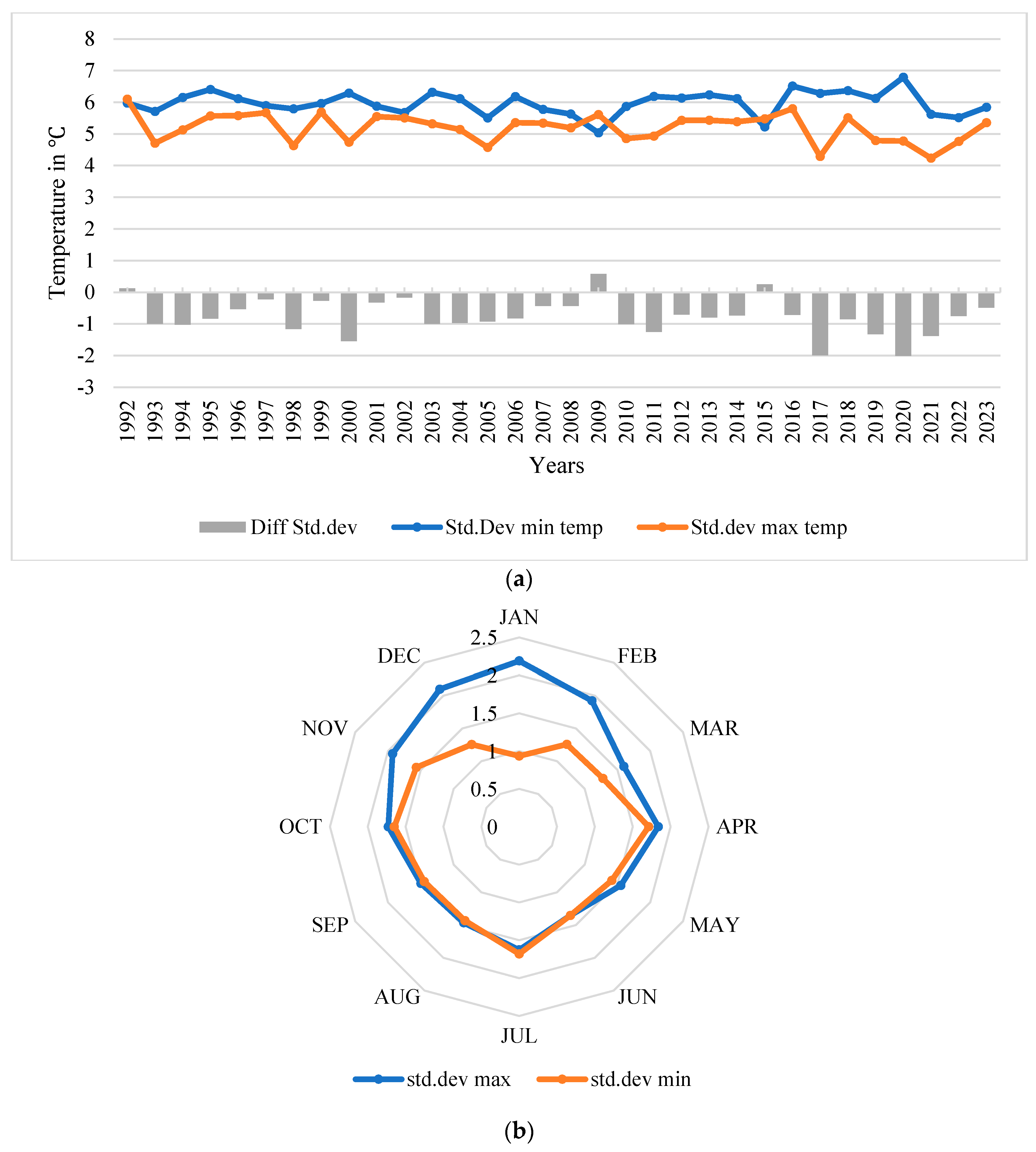
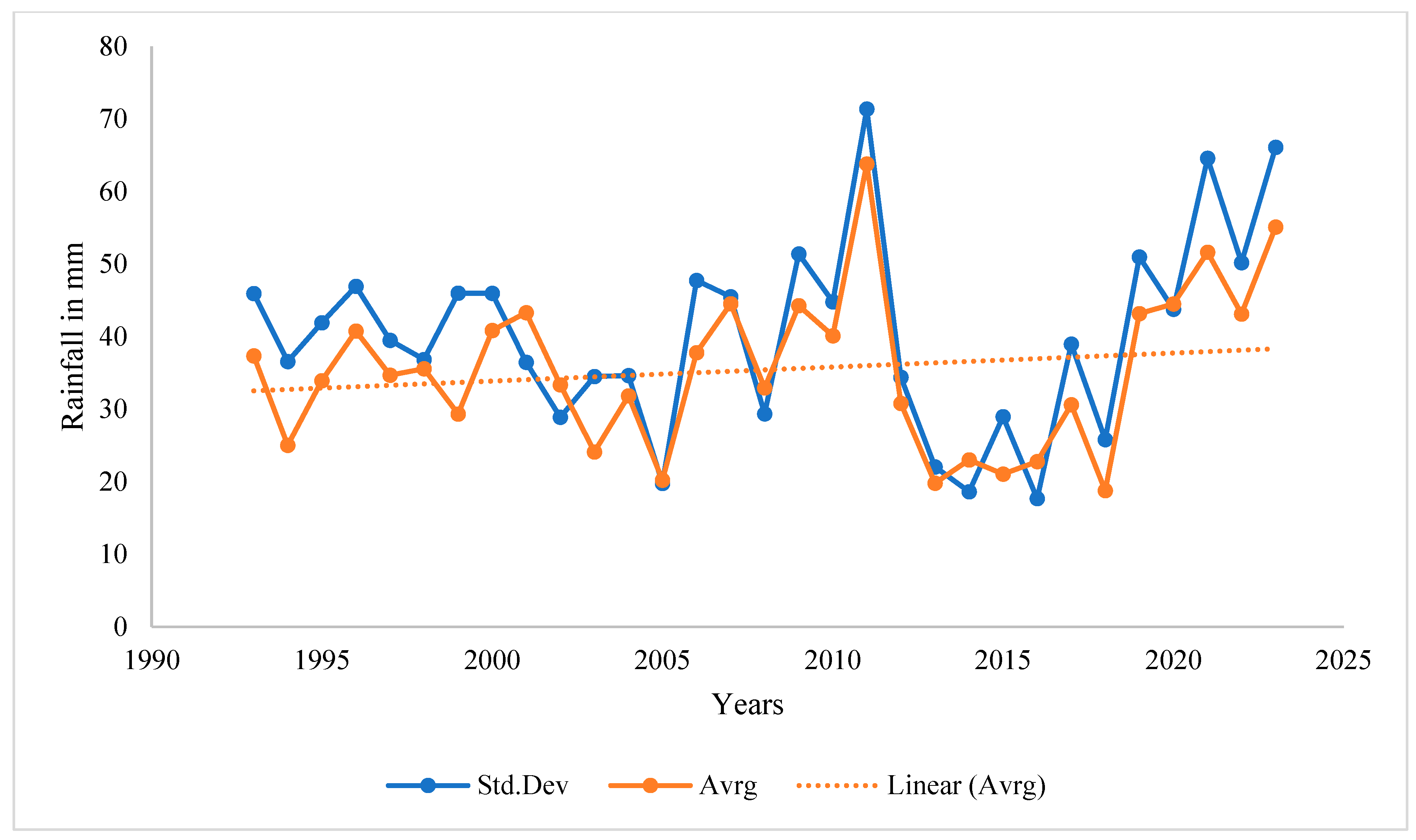
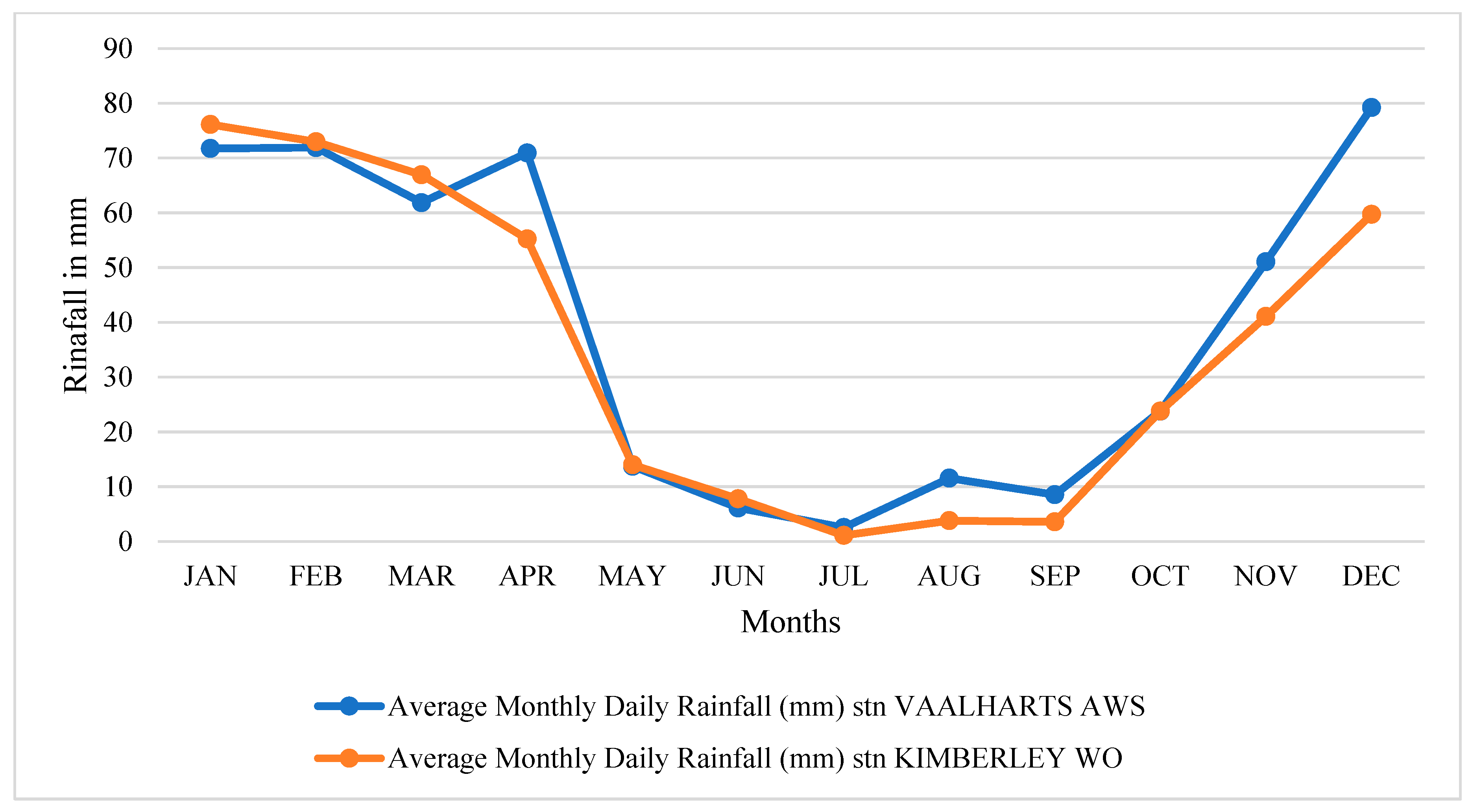
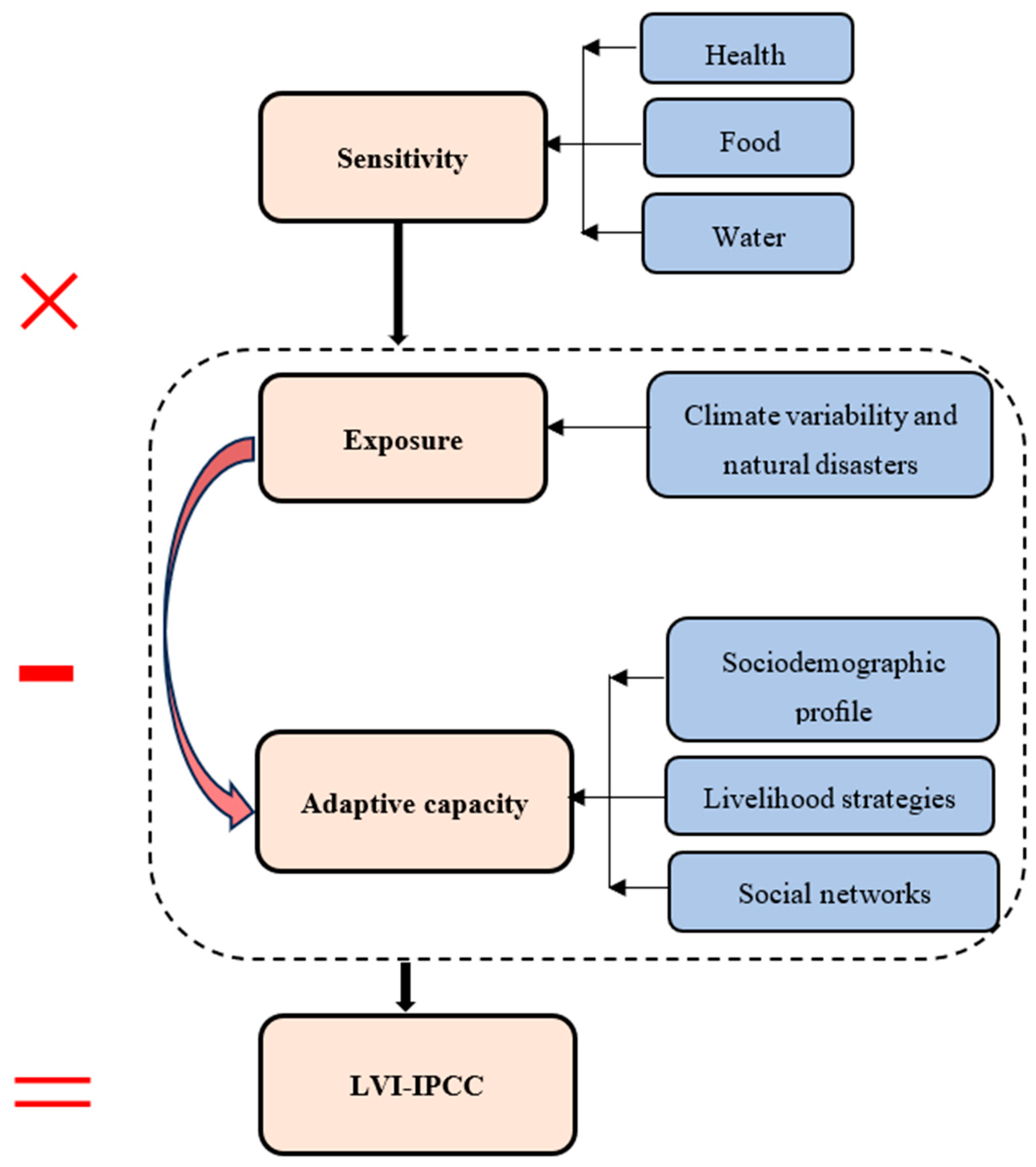
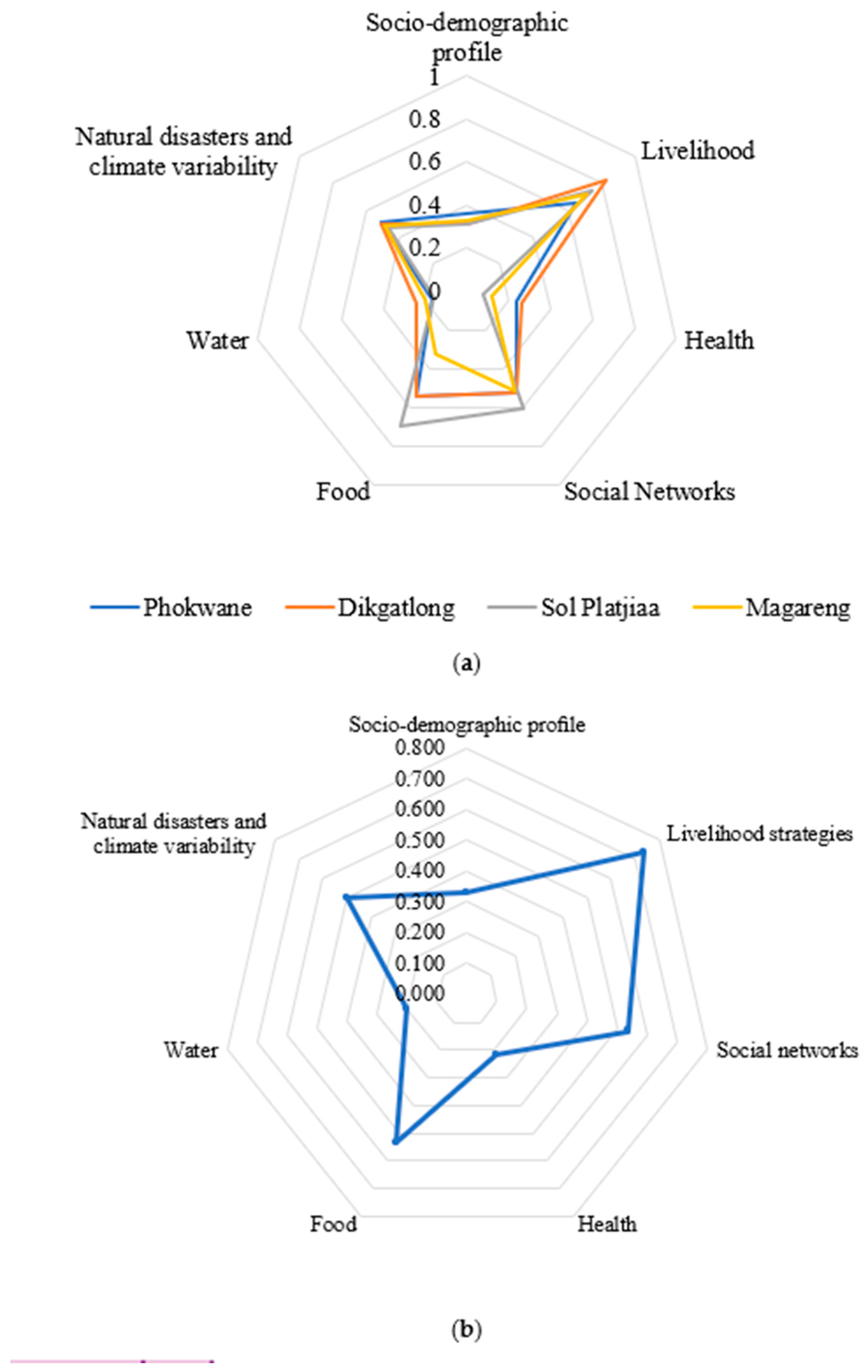
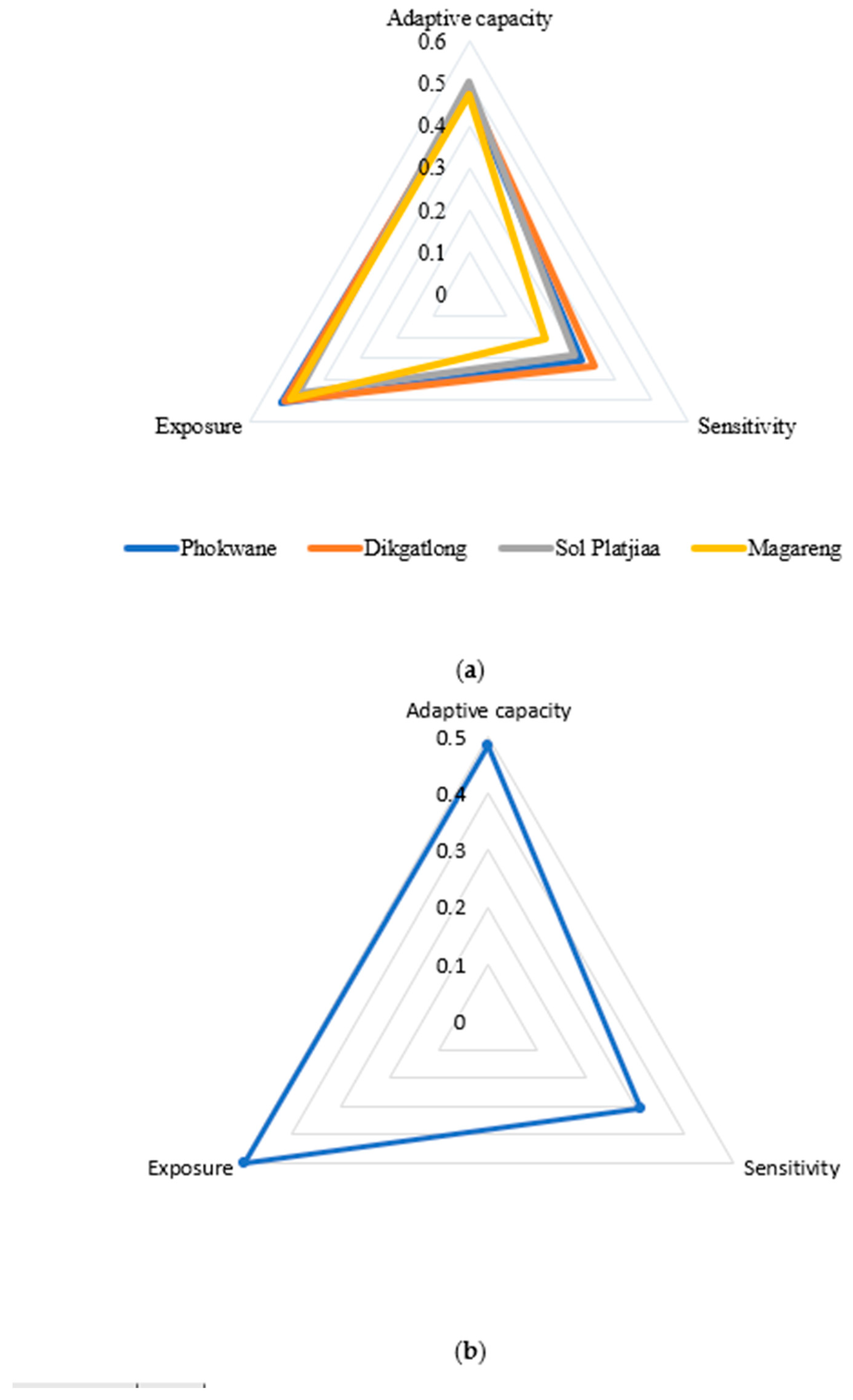
| Freq | % | Mean | Median | St.dev | Min | Max | ||
|---|---|---|---|---|---|---|---|---|
| Age (years) | 21–30 | 13 | 5.99 | 51.66 | 52 | 14.16 | 21 | 85 |
| 31–40 | 42 | 19.35 | ||||||
| 41–50 | 42 | 19.35 | ||||||
| 51–60 | 59 | 27.19 | ||||||
| 61+ | 61 | 28.11 | ||||||
| Sex | Female | 61 | 28.1 | 0.72 | 0.45 | 0 | 1 | |
| Male | 156 | 71.9 | ||||||
| Education | Primary | 118 | 54.38 | 8.01 | 9 | 4.31 | 0 | 16 |
| Secondary | 91 | 41.94 | ||||||
| Tertiary | 8 | 3.68 | ||||||
| Household size | 1–10 | 204 | 94 | 4.97 | 5 | 2.88 | 1 | 25 |
| 11–25 | 13 | 6 | ||||||
| Farming experience (years) | 0.5–20 | 196 | 90.32 | 10.92 | 9 | 8.86 | 0.5 | 60 |
| 21–60 | 21 | 9.68 | ||||||
| Livestock holding | Cattle | 14.72 | 7 | 22.60 | 0 | 200 | ||
| Sheep | 13.97 | 9 | 19.64 | 0 | 121 | |||
| Goats | 17.03 | 10 | 22.50 | 0 | 198 | |||
| Chickens | 40.26 | 10 | 140.36 | 0 | 1000 | |||
| Pigs | 3.48 | 0 | 7.95 | 0 | 52 | |||
| Land size (ha) | 477.04 | 1 | 1338.38 | 0 | 9400 |
| LVI Components | Subcomponents | Subcomponent Value for All the LMs | Index (sd) | |||||||
|---|---|---|---|---|---|---|---|---|---|---|
| Unit | Maximum Value | Minimum Value | Overall Index Value | Phokwane | Dikgatlong | Sol Plaatje | Magareng | |||
| Sociodemographic profile | Dependency ratio; | Ratio | 4.41 | 12.5 | 1 | 0.297 | 0.342 | 0.269 | 0.213 | 0.312 |
| Percent of female-headed HHs; | Percent | 28.5 | 100 | 0 | 0.285 | 0.434 | 0.159 | 0.250 | 0.261 | |
| Percent of HHs where the head did not attend school; | Percent | 12.0 | 100 | 0 | 0.120 | 0.167 | 0.111 | 0.000 | 0.087 | |
| Average age of HH heads; | Years | 51.66 | 85 | 21 | 0.479 | 0.453 | 0.500 | 0.531 | 0.469 | |
| Education level of HH head; | Years | 8.01 | 16 | 0 | 0.501 | 0.438 | 0.500 | 0.500 | 0.563 | |
| Average age of female HH heads; | Years | 50 | 79 | 23 | 0.482 | 0.482 | 0.482 | 0.571 | 0.411 | |
| Average HH size. | 4.97 | 25 | 1 | 0.165 | 0.208 | 0.125 | 0.125 | 0.208 | ||
| Md | 0.333 | 0.361 | 0.307 | 0.313 | 0.330 | |||||
| Livelihood strategies | Percentage of HHs with family members working outside the community; | Percent | 69 | 100 | 0 | 0.690 | 0.531 | 0.862 | 0.632 | 0.652 |
| Percent of households dependent solely on agriculture as a source of income; | Percent | 78.3 | 100 | 0 | 0.783 | 0.738 | 0.822 | 0.800 | 0.783 | |
| Average Agricultural Livelihood Diversification Index (range: 0.20–1) = (1/(number of occupation + 1)). | ALDI | 0.4343 | 0.5 | 0.25 | 0.737 | 0.680 | 0.800 | 0.800 | 0.720 | |
| Md | 0.737 | 0.650 | 0.828 | 0.744 | 0.718 | |||||
| Health | Percentage of households in which a family member had to miss school or work due to drought; | Percent | 17.1 | 100 | 0 | 0.171 | 0.214 | 0.178 | 0.050 | 0.087 |
| Percentage of households that experienced anxiety and depression due to drought; | Percent | 27.6 | 100 | 0 | 0.276 | 0.226 | 0.344 | 0.150 | 0.304 | |
| Percent of HHs that experienced depression due to livestock death; | Percent | 23.5 | 100 | 0 | 0.235 | 0.262 | 0.289 | 0.100 | 0.043 | |
| Percent of HHs with poor health conditions because of drought. | Percent | 19.8 | 100 | 0 | 0.198 | 0.250 | 0.233 | 0.000 | 0.043 | |
| Md | 0.220 | 0.238 | 0.261 | 0.075 | 0.119 | |||||
| Social Networks | Percentage of HHs that have not gone to government or non-governmental organisations for assistance; | Percent | 77.6 | 100 | 0 | 0.776 | 0.805 | 0.744 | 1.000 | 0.556 |
| Percentage of HHs using the internet; | Percent | 47 | 100 | 0 | 0.470 | 0.452 | 0.467 | 0.600 | 0.435 | |
| Percentage of HHs that participated in the village assistance activities | Percent | 11.4 | 100 | 0 | 0.114 | 0.114 | 0.114 | 0.114 | 0.114 | |
| Percentage of HHs owning a mobile phone; | Percent | 59.5 | 100 | 0 | 0.595 | 0.560 | 0.596 | 0.650 | 0.682 | |
| Percentage of HHs without radios; | Percent | 34.8 | 100 | 0 | 0.348 | 0.296 | 0.395 | 0.300 | 0.391 | |
| Percentage of people who have not borrowed or lent money in the past month. | Percent | 91.2 | 100 | 0 | 0.912 | 0.940 | 0.867 | 1.000 | 0.913 | |
| Md | 0.536 | 0.528 | 0.531 | 0.611 | 0.515 | |||||
| Food | Percentage of households in which the food consumption pattern decreased due to drought; | Percent | 62.2 | 100 | 0 | 0.622 | 0.667 | 0.633 | 0.800 | 0.261 |
| Percentage of households in which choice of food preferences was affected because of drought; | Percent | 55.3 | 100 | 0 | 0.553 | 0.536 | 0.567 | 0.800 | 0.348 | |
| Average Livestock Diversification Index (calculated by Margalef Diversification Index). | Livestock DI | 0.4295 | 1 | 0 | 0.430 | 0.420 | 0.440 | 0.510 | 0.370 | |
| Md | 0.535 | 0.541 | 0.547 | 0.703 | 0.326 | |||||
| Water | Percentage of HHs using natural water sources; | Percent | 19.87 | 100 | 0 | 0.199 | 0.199 | 0.199 | 0.199 | 0.199 |
| Percent of HHs with water storage; | Percent | 22.7 | 100 | 0 | 0.227 | 0.227 | 0.227 | 0.227 | 0.227 | |
| Percent of HHs having enough drinking water for livestock. | Percent | 18 | 100 | 0 | 0.180 | 0.083 | 0.300 | 0.050 | 0.174 | |
| Md | 0.202 | 0.170 | 0.242 | 0.159 | 0.200 | |||||
| Natural disasters and climate variability | Mean standard deviation of monthly average minimum daily temperature (1992–2020); | °C | 5.9738 | 6.7882 | 5.0361 | 0.535 | 0.517 | 0.517 | 0.517 | 0.517 |
| The mean standard deviation of monthly average maximum daily temperature (2010–2020); | °C | 5.2000 | 6.0971 | 4.2349 | 0.518 | 0.514 | 0.514 | 0.514 | 0.514 | |
| Mean standard deviation of monthly average precipitation (2010–2020); | mm | 40.1921 | 71.3491 | 17.6709 | 0.420 | 0.472 | 0.472 | 0.472 | 0.472 | |
| Percentage of HHs suffering any loss (agriculture or livestock) to natural disasters, including death, in the last five years; | Percent | 67.7 | 100 | 0 | 0.677 | 0.679 | 0.711 | 0.600 | 0.609 | |
| Average number of livestock lost due to climate and weather-related events; | LU | 21.69 | 303 | 3 | 0.062 | 0.030 | 0.097 | 0.047 | 0.057 | |
| Percentage of HHs that experienced high environmental impact due to drought; | Percent | 56.2 | 100 | 0 | 0.562 | 0.619 | 0.511 | 0.500 | 0.609 | |
| Percentage of HHs that experienced high financial impact due to drought; | Percent | 62.2 | 100 | 0 | 0.622 | 0.655 | 0.600 | 0.550 | 0.652 | |
| Percentage of HHs that experienced high personal impact due to drought. | Percent | 59.4 | 100 | 0 | 0.594 | 0.619 | 0.611 | 0.550 | 0.478 | |
| Md | 0.499 | 0.513 | 0.504 | 0.469 | 0.489 | |||||
| LVI | 0.436 | 0.436 | 0.449 | 0.433 | 0.398 | |||||
| Subcomponents | Major Component Values | Number of Subcomponents per Major Component | |||||
|---|---|---|---|---|---|---|---|
| Phokwane | Dikgatlong | Sol Plaatje | Magareng | General | |||
| Adaptive capacity | Sociodemographic profile | 0.361 | 0.307 | 0.313 | 0.330 | 0.333 | 7 |
| Livelihood strategies | 0.650 | 0.828 | 0.744 | 0.718 | 0.737 | 3 | |
| Social networks | 0.528 | 0.531 | 0.611 | 0.515 | 0.536 | 6 | |
| Sensitivity | Health | 0.238 | 0.261 | 0.075 | 0.119 | 0.220 | 4 |
| Food | 0.541 | 0.547 | 0.703 | 0.326 | 0.535 | 3 | |
| Water | 0.170 | 0.242 | 0.159 | 0.200 | 0.202 | 3 | |
| Exposure | Natural disasters and climate variability | 0.513 | 0.504 | 0.469 | 0.489 | 0.499 | 8 |
| Contributing factor values | Adapd | 0.477 | 0.488 | 0.505 | 0.472 | 0.485 | |
| Sensd | 0.308 | 0.341 | 0.289 | 0.206 | 0.309 | ||
| Expd | 0.513 | 0.504 | 0.469 | 0.489 | 0.499 | ||
| LVI-IPCC Value | 0.011 | 0.005 | −0.011 | 0.003 | 0.004 | ||
Disclaimer/Publisher’s Note: The statements, opinions and data contained in all publications are solely those of the individual author(s) and contributor(s) and not of MDPI and/or the editor(s). MDPI and/or the editor(s) disclaim responsibility for any injury to people or property resulting from any ideas, methods, instructions or products referred to in the content. |
© 2024 by the authors. Licensee MDPI, Basel, Switzerland. This article is an open access article distributed under the terms and conditions of the Creative Commons Attribution (CC BY) license (https://creativecommons.org/licenses/by/4.0/).
Share and Cite
Bahta, Y.T.; Nyaki, S.A. Livelihood Vulnerability from Drought among Smallholder Livestock Farmers in South Africa. Hydrology 2024, 11, 137. https://doi.org/10.3390/hydrology11090137
Bahta YT, Nyaki SA. Livelihood Vulnerability from Drought among Smallholder Livestock Farmers in South Africa. Hydrology. 2024; 11(9):137. https://doi.org/10.3390/hydrology11090137
Chicago/Turabian StyleBahta, Yonas T., and Stephen Aniseth Nyaki. 2024. "Livelihood Vulnerability from Drought among Smallholder Livestock Farmers in South Africa" Hydrology 11, no. 9: 137. https://doi.org/10.3390/hydrology11090137
APA StyleBahta, Y. T., & Nyaki, S. A. (2024). Livelihood Vulnerability from Drought among Smallholder Livestock Farmers in South Africa. Hydrology, 11(9), 137. https://doi.org/10.3390/hydrology11090137






